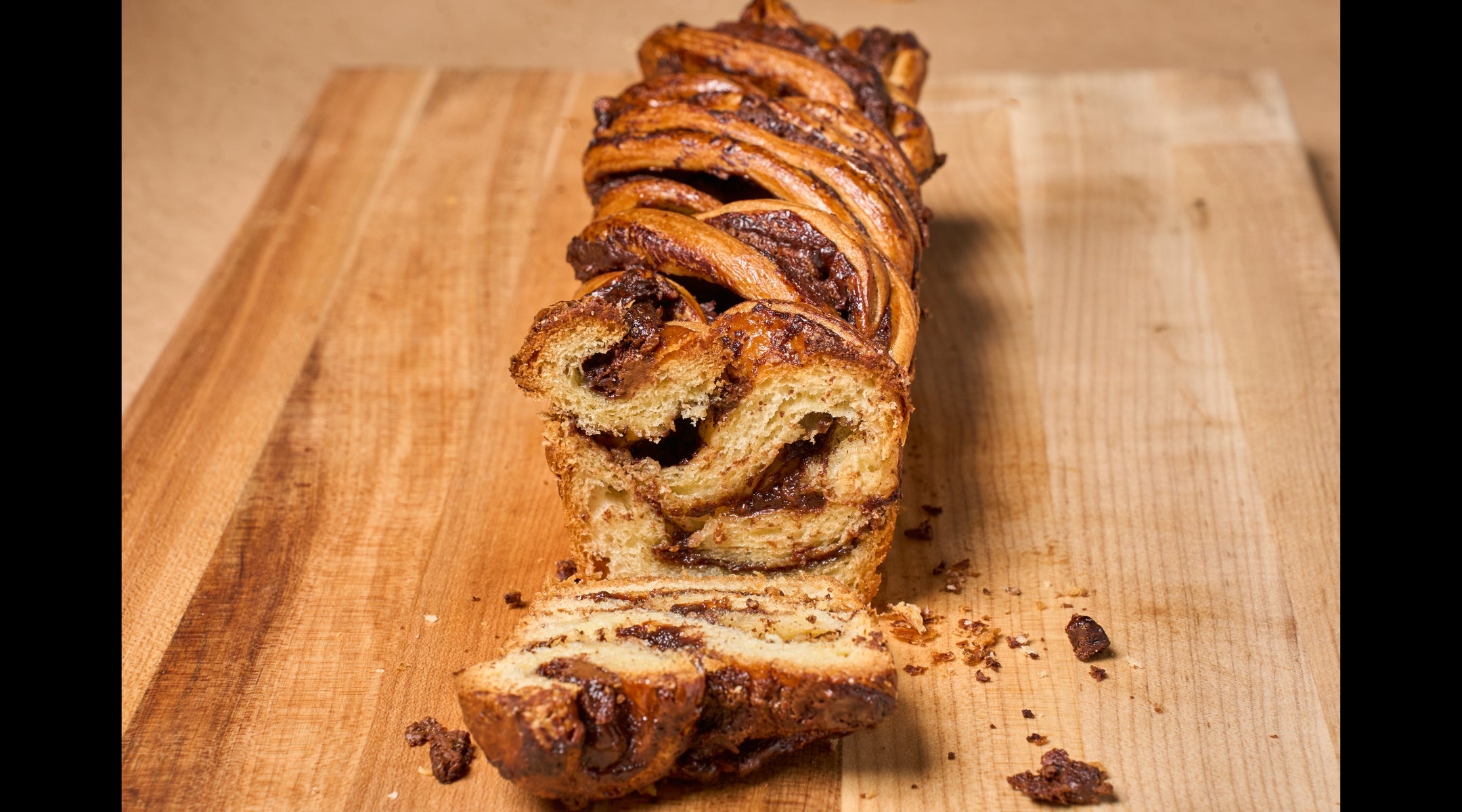Uncategorized
These Jewish baked goods made the New York Times’ list of ‘25 Essential Pastries’ in NYC

Inspired by the “bakery renaissance” that’s currently underway across New York City — if you spot a line somewhere, there’s a very good chance there are baked goods at the end of it — T: The New York Times Style Magazine has assembled a list of “The 25 Essential Pastries to Eat in New York City.”
Among those on the list are several Jewish treats, including a buttery, chocolatey babka that’s made New Yorkers’ mouths water since 2013 and a tiny knish filled with sauerkraut and dill from a buzzy new bakery on the Lower East Side.
To assemble their of list 25 standout pastries — a tough task, we imagine — the magazine assembled a panel of renowned bakers: pastry chef and writer Tanya Bush; pastry chef Camari Mick; chef and Milk Bar founder Christina Tosi; Bánh by Lauren founder and pastry chef Lauren Tran; Shaun Velez, executive pastry chef at Daniel; and baker and cookbook author Melissa Weller.
Among the panel’s picks are some beloved old-school sweets like Lloyd’s Carrot Cake and the sour cream glazed doughnut from Peter Pan Donut & Pastry Shop; upscale creations like the Lysee mousse cake from Lysee and four Jewish-inspired desserts. Keep scrolling to see, in alphabetical order, which Jewish pastries are on the Times’ list.
1. Agi’s Counter’s cheesecake
Opened in 2021 by Brooklyn-based Jewish chef Jeremy Salamon, Agi’s Counter (818 Franklin Ave.) was inspired by Salamon’s grandmother, Agi, a Hungarian Jew and a Holocaust survivor.
“Most people, when they hear Hungarian, if they have any idea the first thing that comes to mind is probably paprika or goulash — maybe chicken paprikás,” Salamon, a James Beard Award-nominated chef, told the New York Jewish Week last summer. “The concept is so limited.”
The cheesecake at Agi’s Counter has been on offer since the restaurant opened — in fact, for a while, it was the only dessert on the menu. “A riff on the dense, creamy New York style often credited to Arnold Reuben, who made it a century ago at his Jewish diner, Reuben’s Restaurant in Midtown, and later popularized at diners like Junior’s, which first opened in 1950 in Downtown Brooklyn, Salamon’s version is a thick wedge made with Philadelphia cream cheese on a crushed graham cracker crust,” the magazine describes.

The cheesecake at Agi’s Counter with a blueberry compote. (Screenshot via Agi’s Counter Instagram)
At Agi’s Counter, the “well-executed take on a classic” is served topped with extra virgin olive oil, Maldon salt and a lemon wedge during dinner service. As part of the weekend brunch menu, it is topped with a blueberry and coriander compote.
“It was like $18, and I was there for lunch, so the dessert was actually the most expensive part,” said Tran. “I thought, ‘Oh, bold.’ And then I was blown away.”
While you’re there, don’t miss Agi’s Counter’s tuna melt, which features “oily, slow-cooked tuna, alpine Cheddar, pickled peppers, celery, dill and Kewpie mayo. Last year, it was one of 11 Jewish sandwiches on the New York Times’ list of “57 Sandwiches That Define New York City.”
2. Breads’ chocolate babka
The chocolatey, buttery, braided babka at Breads Bakery has been delighting New Yorkers since 2013, when the Israeli-inspired spot first opened near Union Square.
Breads’ buttery, laminated dough — “crispy-edged, springy and oozing with a Nutella-and-chocolate filling” per the Times — reignited the popularity of this Ashkenazi dessert across the city (and eventually in Paris, too.)
Today, Breads has six locations around the city, and its babka has become a New York icon — the bakery reportedly sells over 1,000 babkas a day during the winter holidays, per the Times. Co-founder and owner Gadi Peleg refers to his baker as “the house that babka built.”
According to panelist Weller, Breads “started a trend of babka, and also the trend of laminated doughs being used in different ways.”
Added Tosi: “He really defied the odds of how much chocolate one could put in babka.”
3. Elbow Bread’s potato sauerkraut knish
The Lower East Side’s buzzy Elbow Bread (1 Ludlow St.) opened last October, where baker Zoë Kanan has been busy creating old-school Jewish baked goods with a modern twist.
Backed by partners Eric Finkelstein and Matt Ross, the founders of the popular Flatiron Jewish luncheonette S&P, Kanan — who’s been called “a baker’s baker” by New York Magazine — turns out delicacies like bialys and rugelach, as well as contemporary hybrids like a challah honey bun, which is part croissant, part challah and “our sweetest ooey, gooey item,” Kanan told the New York Jewish Week.
“There aren’t many Jewish bakeries here anymore,” Kanan said. “I saw an opportunity to do something here [on the Lower East Side], in a location with so much Jewish history, and bringing my own personal style to it, which borrows from a lot of different techniques and ingredients. I love the classics and tradition is important, but what I find myself thinking about is ways to reinterpret.”
The pastry that made the T Magazine list is a savory one: a tiny sauerkraut knish, made of flaky laminated pastry wrapped around mashed Yukon Gold potatoes “flecked with crunchy salt and flavored with sauerkraut, onions, sour cream and fresh dill.”
“Knish was this thing that you just didn’t want,” panelist Weller said of the small pastry. “I love that she decided to reinvent it. Because it needed that.”
4. Fan-Fan Doughnuts’ guava and cheese fan-fan
After successfully launching the NYC mini-chain Dough Doughnuts and ice pop company La Newyorkina in 2010, Mexican-Jewish pastry chef Fany Gerson opened her Brooklyn doughnut shop Fan-Fan Doughnuts (448 Lafayette Ave.) in the fall of 2020. Despite launching during the pandemic, lines formed out the door.
In her work, as in her life, Gerson enjoys reflecting on the richness of her Jewish and Mexican heritages. “I feel like through time I’ve explored it through food and I’m kind of bridging the two worlds,” Gerson told the New York Jewish Week in 2021.

A close-up of the guava and cheese fan-fans at Fan-Fan Doughnuts. (Screenshot via Fan-Fan Doughnuts Instagram)
During Hanukkah, Gerson sells delicious and inventive sufganiyot, which are traditionally fried, round jelly-filled doughnuts that are enjoyed during the holiday. But the pastry that made the Times’ list can be enjoyed year-round: an éclair-inspired doughnut, known as a fan-fan, that’s filled with cream cheese, glazed with guava and topped by a brown butter walnut cookie crumble.
The treat is “inspired by the guava cheese roll from one of her favorite Mexico City bakeries,” according to the Times.
“That’s the thing about food, it’s not ephemeral,” Gerson told us. “How many memories are tied to food? A smell can take you back.”
—
The post These Jewish baked goods made the New York Times’ list of ‘25 Essential Pastries’ in NYC appeared first on Jewish Telegraphic Agency.
Uncategorized
Rep. Ilhan Omar says Stephen Miller’s comments on immigrants sound like how ‘Nazis described Jewish people’
Rep Ilhan Omar, Democrat of Minnesota, on Sunday likened the Trump administration’s immigration rhetoric to Nazi depictions of Jews.
“It reminds me of the way the Nazis described Jewish people in Germany,” Omar said in an interview on CBS’s Face the Nation, commenting on a social media post by Stephen Miller, President Donald Trump’s senior adviser, in which he suggested that “migrants and their descendants recreate the conditions, and terrors, of their broken homelands.” Miller, who is Jewish, is the architect of the Trump administration’s immigration policy.
Omar called Miller’s comments “white supremist rhetoric” and also drew parallels between his characterization of migrants seeking refuge in the U.S. to how Jews were demonized and treated when they fled Nazi-era Germany. “As we know, there have been many immigrants who have tried to come to the United States who have turned back, you know, one of them being Jewish immigrants,” she said.
Now serving as Trump’s deputy chief of staff for policy, Miller is central to the White House’s plans for mass deportations and expanded barriers to asylum. During Trump’s first term, Miller led the implementation of the so-called Muslim travel ban in 2017, which barred entry to the U.S. for individuals from Iran, Iraq, Libya, Somalia, Sudan, Syria, and Yemen, and pushed to further reduce a longtime refugee program.
Rep. Ilhan Omar: “When I think about Stephen Miller and his white supremacist rhetoric, it reminds me of the way the Nazis described Jewish people in Germany.” pic.twitter.com/GAjIMqFq26
— Aaron Rupar (@atrupar) December 7, 2025
Miller’s comments echoed similar rhetoric by Trump after an Afghan refugee was accused of shooting two National Guard members near the White House last month, killing one.
Trump told reporters at a cabinet meeting last week that Somali immigrants are “garbage” and that he wanted them to be sent “back to where they came from.” The president also singled out Omar, a Somali native who represents Minnesota’s large Somali-American community. “She should be thrown the hell out of our country,” Trump said.
In the Sunday interview, Omar called Trump’s remarks “completely disgusting” and accused him of having “an unhealthy obsession” with her and the Somali community. “This kind of hateful rhetoric and this level of dehumanizing can lead to dangerous actions by people who listen to the president,” she said.
The post Rep. Ilhan Omar says Stephen Miller’s comments on immigrants sound like how ‘Nazis described Jewish people’ appeared first on The Forward.
Uncategorized
Nigeria Seeks French Help to Combat Insecurity, Macron Says

French President Emmanuel Macron at the Elysee Palace in Paris, France, Sept. 15, 2025. Photo: REUTERS/Benoit Tessier/Pool
Nigerian President Bola Tinubu has sought more help from France to fight widespread violence in the north of the country, French President Emmanuel Macron said on Sunday, weeks after the United States threatened to intervene to protect Nigeria’s Christians.
Nigeria, Africa’s most populous country, has witnessed an upsurge in attacks in volatile northern areas in the past month, including mass kidnappings from schools and a church.
US President Donald Trump has raised the prospect of possible military action in Nigeria, accusing it of mistreating Christians. The government says the allegations misrepresent a complex security situation in which armed groups target both faith groups.
Macron said he had a phone call with Tinubu on Sunday, where he conveyed France’s support to Nigeria as it grapples with several security challenges, “particularly the terrorist threat in the North.”
“At his request, we will strengthen our partnership with the authorities and our support for the affected populations. We call on all our partners to step up their engagement,” Macron said in a post on X.
Macron did not say what help would be offered by France, which has withdrawn its troops from West and Central Africa and plans to focus on training, intelligence sharing and responding to requests from countries for assistance.
Nigeria is grappling with a long-running Islamist insurgency in the northeast, armed kidnapping gangs in the northwest and deadly clashes between largely Muslim cattle herders and mostly Christian farmers in the central parts of the country, stretching its security forces.
Washington said last month that it was considering actions such as sanctions and Pentagon engagement on counterterrorism as part of a plan to compel Nigeria to better protect its Christian communities.
The Nigerian government has said it welcomes help to fight insecurity as long as its sovereignty is respected. France has previously supported efforts to curtail the actions of armed groups, the US has shared intelligence and sold arms, including fighter jets, and Britain has trained Nigerian troops.
Uncategorized
Netanyahu Says He Will Not Quit Politics if He Receives a Pardon

Israeli Prime Minister Benjamin Netanyahu participates in the state memorial ceremony for the fallen of the Iron Swords War on Mount Herzl, Jerusalem on Oct. 16, 2025. Photo: Alex Kolomoisky/POOL/Pool via REUTERS
Israeli Prime Minister Benjamin Netanyahu said on Sunday that he would not retire from politics if he receives a pardon from the country’s president in his years-long corruption trial.
Asked by a reporter if planned on retiring from political life if he receives a pardon, Netanyahu replied: “no”.
Netanyahu last month asked President Isaac Herzog for a pardon, with lawyers for the prime minister arguing that frequent court appearances were hindering Netanyahu’s ability to govern and that a pardon would be good for the country.
Pardons in Israel have typically been granted only after legal proceedings have concluded and the accused has been convicted. There is no precedent for issuing a pardon mid-trial.
Netanyahu has repeatedly denied wrongdoing in response to the charges of bribery, fraud and breach of trust, and his lawyers have said that the prime minister still believes the legal proceedings, if concluded, would result in a complete acquittal.
US President Donald Trump wrote to Herzog, before Netanyahu made his request, urging the Israeli president to consider granting the prime minister a pardon.
Some Israeli opposition politicians have argued that any pardon should be conditional on Netanyahu retiring from politics and admitting guilt. Others have said the prime minister must first call national elections, which are due by October 2026.


